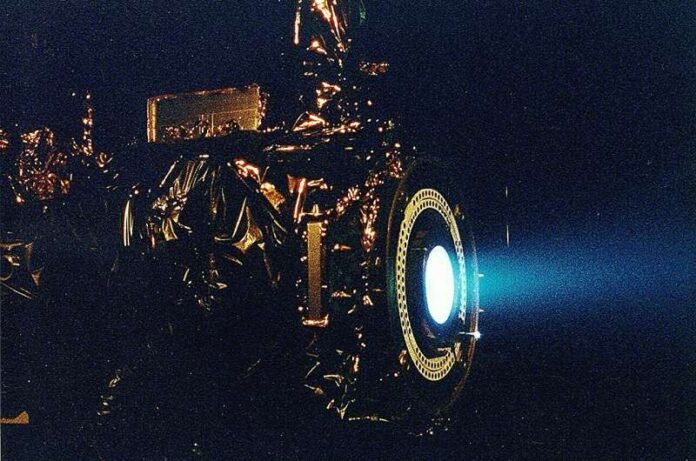Ion thrust. Credit: NASA
Sending an object to another star is still science fiction. But some concrete missions could get us at least partially there. These “interstellar precursor missions” include a journey to the Sun’s gravitational lens point located 550 AU from the Sun – further than any artificial object has ever been, including Voyager.
To achieve that we need many new technologies, and a recent paper presented this month at the 75th International Astronautical Congress in Milan looks at one of those potential technologies: electric propulsion systems, also known as ion propulsions.
The paper aimed to assess when an existing ion propulsion technology could carry a large payload on one of several trajectories, including a trip around Jupiter, a visit to Pluto, and even a trip to the legendary solar gravity lens. To do this, they specified an ‘ideal’ ion drive with characteristics that allowed optimal values for some of the physical characteristics of the system.
The first of these features is the power plant. Ion thrusters need a power source, and an effective one at that, if they are to last more than a decade under thrust. The article defined an ideal energy plan that can deliver 1 kW per kg of weight.
This is currently well beyond the realm of possibility, with the best ion propulsion sources delivering around 10 W per kg and even nuclear electric propulsion systems delivering 100 W per kg. There are some potentially better technologies on the horizon, but nothing tested in the literature yet could meet this requirement.
Thrust efficiency is another consideration for this idealized mission. The authors, writing under the banner of the Initiative for Interstellar Studies, a nonprofit organization based in Britain, suggested that an idealized thrust efficiency is 97%. That would also significantly improve existing technologies, which average closer to 75%-80% efficiency for working models.
Additional improvements could increase this number, such as magnetic containment fields around the thruster walls. But as the 97% range approaches, finding efficiencies becomes increasingly difficult.
The last characteristic the authors looked at was the specific impulse. This has the most extensive variability in terms of theoretical potential of all three systems. Their idealized value of 34,000–76,000 seconds of specific impulse is well within the limits of the potential values for more speculative technologies.
The article mentions that specific impulse values twice as high as the proposed upper range could be possible with proper selection of thruster and propellant. They also point out that the development of these technologies has not stalled because we cannot create drives with better specific impulse, but because we cannot yet produce power plants that support them. Thus, solving the power plant problem will enable further development in this field.
Suppose all three features were combined into a completely functional propulsion system. In that case, the authors calculate that it could deliver a payload of nearly 40,000 pounds (18,000 kg) to the Sun’s gravitational lens in just thirteen years—much faster than any previous mission could do.
But that optimization is still a long way off, and while missions are planned for deployment to the SGL at some point, they are still a long way off from launch and even longer before they get there. In the meantime, engineers have a number of additional problems to solve if they want to maximize the potential of ion thrusters.
More information:
Paper: Advanced electric propulsion systems with optimal specific impulses for fast interstellar precursor missions
Provided by Universe Today
Quote: Ion engines could get us to the Sun’s gravitational lens in less than 13 years, suggests paper (2024, October 25) retrieved October 26, 2024 from https://phys.org/news/2024-10-ion-solar- gravitational-lens-years.html
This document is copyrighted. Except for fair dealing purposes for the purpose of private study or research, no part may be reproduced without written permission. The content is provided for informational purposes only.





